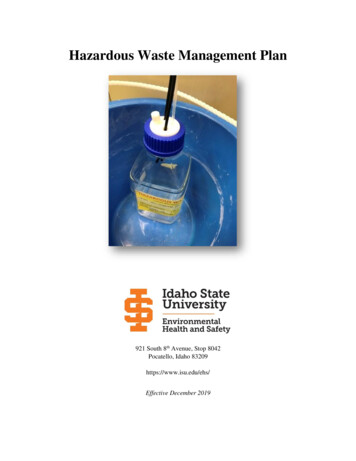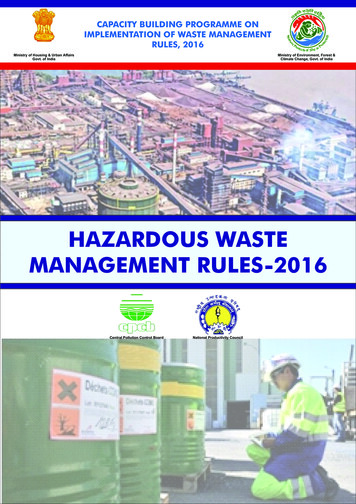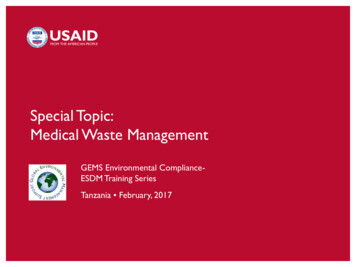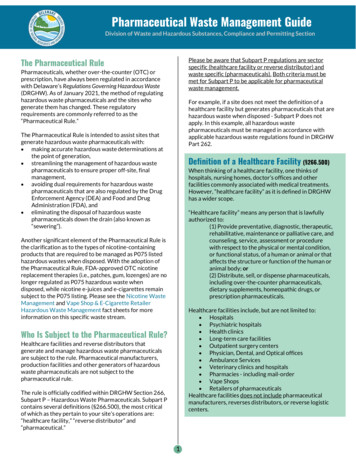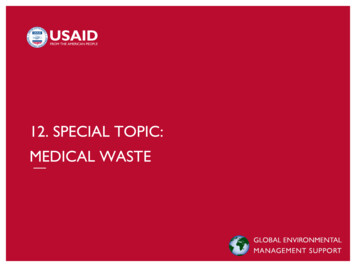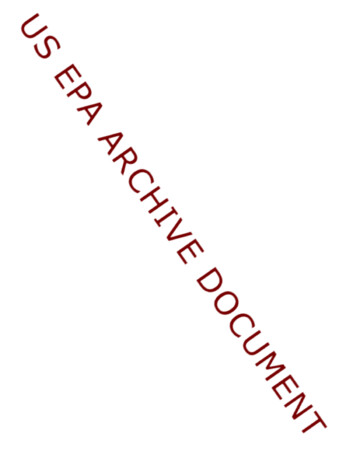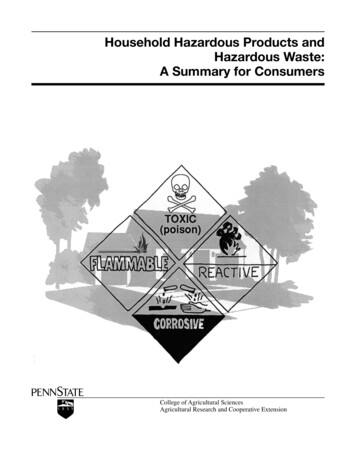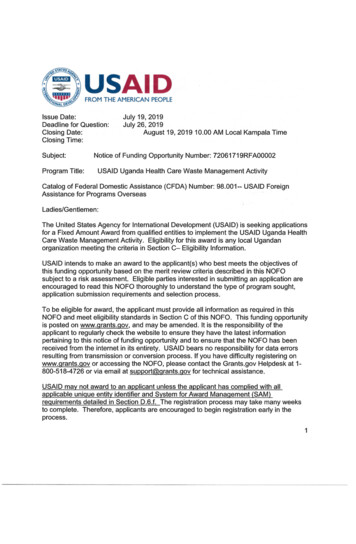
Transcription
HAZARDOUS WASTE MANAGEMENT PROGRAMDate Created: January 2011Date Revised: February 2020
Hazardous Waste Management ProgramREVISION HISTORYRevision NumberDocument Section0Details ofAmendmentsDateNew ProgramJanuary 20111AllReview & UpdateSeptember 20182AllAODA ComplianceFebruary 2020Revised February 2020Page 1 of 8
Hazardous Waste Management ProgramTABLE OF CONTENTS1.0Related Legislation and Guidelines: . 32.0Related University Guidelines and Procedures . 33.0Intent . 34.0Responsibilities: . 34.1Managers and supervisors . 34.2Waste generators (not construction related). 44.3Design Engineering and Construction, Physical Resources . 44.4Regional Campus and Research Stations. 44.5Environmental Health and Safety (EHS) . 45.0Minimum Standards for Hazardous Waste Disposal Contractors . 56.0Funding for Hazardous Waste Disposal. 67.0Hazardous Waste Streams . 67.1Chemical. 67.2Compressed gases . 77.3Potentially Explosive Materials . 77.4PCBs . 77.5Biohazardous . 77.5.1Steam sterilization (autoclaving): . 77.5.2Incineration or caustic digestion: . 87.6Radioactive . 88.0Hazardous Waste Disposal Procedures . 89.0Glossary of Terms . 8Revised February 2020Page 2 of 8
Hazardous Waste Management Program1.0RELATED LEGISLATION AND GUIDELINES:R.R.O. 1990, Reg. 347: General - Waste ManagementMOECP - Registration guidance manual for generators of liquid industrial and hazardous waste2.0RELATED UNIVERSITY GUIDELINES AND PROCEDURESUniversity of Guelph - Hazardous Waste Management ProceduresUniversity of Guelph – Hazardous Waste Management Guideline for the Regional Campus andResearch Stations3.0INTENTTo outline the scope and components of the Hazardous Waste Management program andprescribe the associated responsibilities to relevant members of the University of Guelphcommunity.Guidance regarding management of non-hazardous wastes at the University can be foundthrough the Sustainability Office.4.04.1RESPONSIBILITIES:Managers and supervisorsa. Provide adequate resources for responsible hazardous waste management within theirworkspaces.b. Include provision for handling of hazardous waste when planning projects such thatwaste minimization strategies are incorporated as feasible.c. Require that all hazardous wastes generated in their workplaces are safely contained,appropriately identified and disposed of according to the University’s hazardous wastedisposal procedures.d. Responsibly manage hazardous materials inventories for each laboratory.Revised February 2020Page 3 of 8
Hazardous Waste Management Program4.2Waste generators (not construction related)a. Follow appropriate hazardous waste disposal procedures such that hazardous waste isidentified accurately, packaged appropriately and stored safely.b. Dispose hazardous waste regularly and as identified. Update chemical inventories atleast annually and purge chemicals as required.4.3Design Engineering and Construction, Physical Resourcesa. Incorporate provision for utilizing hazardous waste disposal contractors meeting thedefined minimum standards into the scope of construction projects.b. Incorporate responsible hazardous waste management into construction projects asapplicable.c. Require approval of associated waste manifests through Environmental Health andSafety (EHS) department.4.4Regional Campus and Research Stationsa. Develop and manage location-specific hazardous waste disposal procedures. Follow theUniversity of Guelph Hazardous (Subject) Waste Management Guideline for RegionalCampus and Research Stations.b. Only use University of Guelph waste generator number(s) under the guidance and withthe approval of EHS.c. Apply defined minimum standards for hazardous waste disposal contractors for allhazardous waste removal.d. Require that waste manifests are approved by a University employee with currentTransportation of Dangerous Goods (TDG) certification.e. Maintain waste manifests (TDG documentation) for a minimum of two years.4.5Environmental Health and Safety (EHS)a. Coordinate and provide support related to hazardous waste disposal services for GuelphCampus, the regional campuses and research stationsb. Communicate and make readily available hazardous waste procedures to Universitywaste generators.c. Maintain generator registrations and good standing with the Ministry of the EnvironmentConservation and Park’s Hazardous Waste Information Network (HWIN) and add,modify or remove waste classes for all University of Guelph sites (including the regionalcampus and research stations) as required.Revised February 2020Page 4 of 8
Hazardous Waste Management Programd. Maintain current TDG certification for the department and approve waste manifests forGuelph Campus.e. Permit and approve use of University of Guelph waste generator numbersf.Maintain waste manifests (TDG documentation) from Guelph Campus for a minimum oftwo years.g. Maintain waste characterization information for a minimum of three years (e.g. wasteprofiles, laboratory analyses, etc.)h. Provide regular Hazardous Waste Management training opportunities5.0MINIMUM STANDARDS FOR HAZARDOUS WASTE DISPOSALCONTRACTORSHazardous waste disposal is highly regulated and as such has significant associated liability.To protect the environment, the safety of the University Community and to meetregulatory obligations , the following criteria for hazardous waste disposal contractors hired bythe University of Guelph have been defined: No regulatory infractions in the past 5 years or submission of regulatory infractions withinthe past 5 years along with corrective actions for review No company name changes in past 5 years or submission of company regulatory historyunder previous name(s) for review Environmentally responsible final waste disposal, to meet compliance with relevant actsand regulations Adequate insurance as determined by current recommendations of the University’sInsurance office, including transport and commercial general liability, errors andomissions and environmental impairment insurance Certificate of insurance must name U of G as additionally insured party Proof of Worker’s Safety and Insurance Board (WSIB) coverage and letter of standingfrom WSIB Submission of Health and Safety program if required Solid understanding of the Provincial hazardous waste legislation, waste manifestingsystem, Transportation of Dangerous Goods requirements, WHMIS and all additionalrelevant statutes and regulationsRegulatory history is a significant factor in choosing a responsible waste disposal contractor andthis factor is to be included during assessment of disposal companies. The University must beconfident and assured its regulatory obligations can be met. Infractions involving illegal orirresponsible waste disposal practices will not be toleratedRevised February 2020Page 5 of 8
Hazardous Waste Management Program6.0FUNDING FOR HAZARDOUS WASTE DISPOSALHazardous waste disposal is centrally funded by the University with the following exceptions: Gas cylinders Potentially explosive materials Materials of unknown identity Waste generated from the following locations or activities:7.0oRegional campus and research stationsoCost recovery units e.g. Lab Services Division, Hospitality, Athletics, StudentHealth Services, etc.oWide-spread lab clean-outsoConstruction projects e.g. Polychlorinated Biphenol (PCB) waste, fluorescentbulbs, etc.HAZARDOUS WASTE STREAMSHazardous waste can be divided into chemical, biohazardous and radioactive waste streams.Unless combined through the inherent design of the research, waste streams are to be keptseparate.Types of waste within streams are to be kept separate if possible (e.g. halogenated, nonhalogenated solvents, aqueous, organic and inorganic wastes). Incompatible wastes must besegregated to protect the safety of all University and contractor personnel.Waste manifests must be signed by University of Guelph employees with current TDGcertification. For the Guelph campus this is done through EHS.7.1ChemicalChemical waste management involves removal to off-site treatment/final disposal sites.Waste included in the chemical waste stream includes but is not limited to the following: Surplus, expired or spent laboratory chemicals Batteries, including alkaline, Ni-cad, lead acid, nickel metal hydride, etc. Fluorescent light bulbs, including fluorescent tubes and compact fluorescent bulbs Paints Oils and lubricants Pesticides (including insecticides, herbicides and fungicides) Aqueous wastes unsuitable for sewage disposalRevised February 2020Page 6 of 8
Hazardous Waste Management ProgramChemical waste disposal for the Guelph campus involves regularly scheduled pick-ups byan authorized chemical waste disposal contractor. Chemical waste is then transferred to theChemical Management Centre for lab packing or bulking and transport as appropriate.Specially scheduled removals are arranged for large quantities of chemical waste such aswaste generated from construction projects.Chemical waste disposal for the regional campuses and research stations is scheduled asrequired by site representatives.7.2Compressed gasesGas cylinders are to be leased from the supplier such that the empty cylinders, surplus orexpired gases can be returned to the applicable supplier.Compressed gases that require waste disposal are included in regular chemical wastedisposal programs.7.3Potentially Explosive MaterialsDisposal of potentially explosive materials is scheduled as required and is completed by anauthorized explosives disposal contractor.7.4PCBsWaste considered to be PCB waste includes: PCB oils PCB containing or contaminated equipment where PCB concentrations are greaterthan 50 ppm including electrical ballastsPCB waste disposal involves specially scheduled pick-ups by authorized PCB disposalcontractors.7.5BiohazardousWaste included in the biohazardous waste stream along with treatment methods includesbut is not limited to the following:7.5.1 Steam sterilization (autoclaving):Potentially pathogenic or pathogenic materialo lab trash, contaminated glassware, disposables, agar plates, slantso vaccines, toxinso microbiological cultures, blood products, bodily fluidRevised February 2020Page 7 of 8
Hazardous Waste Management ProgramAutoclaving of biohazardous waste must be done at conditions for the sufficient destructionof hazardous agents (e.g. 120 C at 105 kPa for more than 60 minutes).7.5.2 Incineration or caustic digestion:Transgenic animalsWaste generated from transgenic animals – (bedding, feces, etc.) 1Surgical waste including drapes and blood stained material1Biohazardous waste generated from areas without access to an autoclave1Potentially pathogenic or pathogenico Animal carcasses and body partso Beddingo Feces, etc.Waste for incineration must be sent off-site. Steam sterilization referred to in 7.5.1 may beused on-site.7.6RadioactiveDetails of the radioactive waste management program can be found in the Radiation SafetyManual.8.0HAZARDOUS WASTE DISPOSAL PROCEDURESCurrent hazardous waste disposal procedures for chemical, biohazardous and radioactivewastes on the Guelph campus are included on the EHS website.Hazardous waste management guidelines for the regional campus and research stations arealso available on the EHS website.Hazardous waste management is also discussed in Lab Safety, Biosafety and Radiation safetytraining courses which are offered regularly. Additional training opportunities are to be madeavailable as required.9.0GLOSSARY OF TERMSWaste manifest – a six-part form required through legislation for all removal of hazardous waste.This constitutes the TDG shipping document for hazardous waste.1May not be suitable for caustic digestionRevised February 2020Page 8 of 8
Waste manifests must be signed by University of Guelph employees with current TDG certification. For the Guelph campus this is done through EHS. 7.1 Chemical . Chemical waste management involves removal to off-site treatment/final disposal sites. Waste included in the chemical waste stream includes but is not limited to the following:
